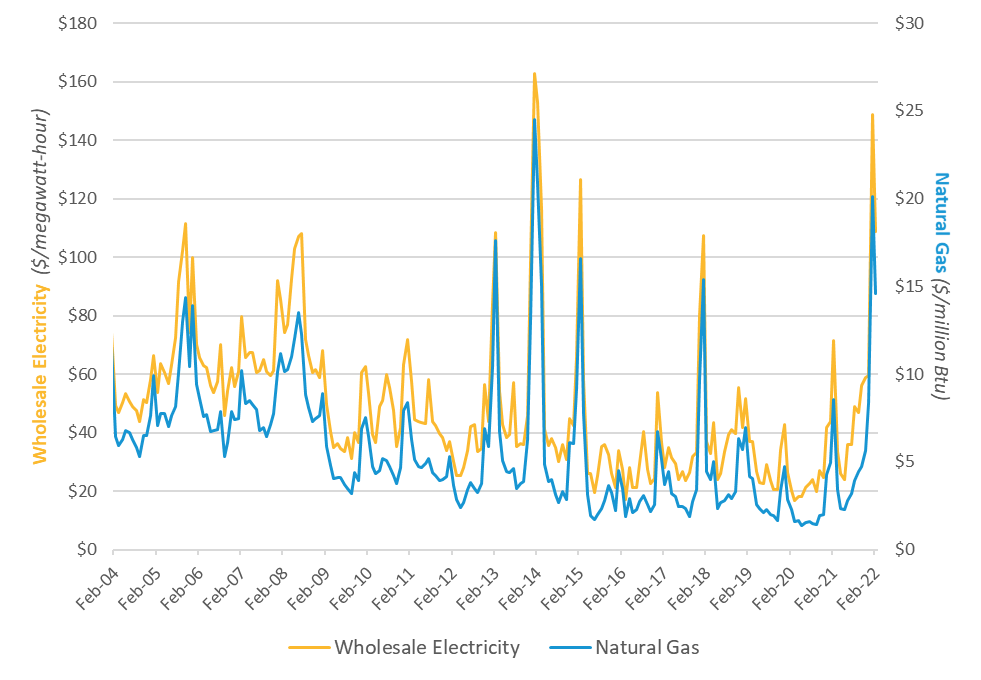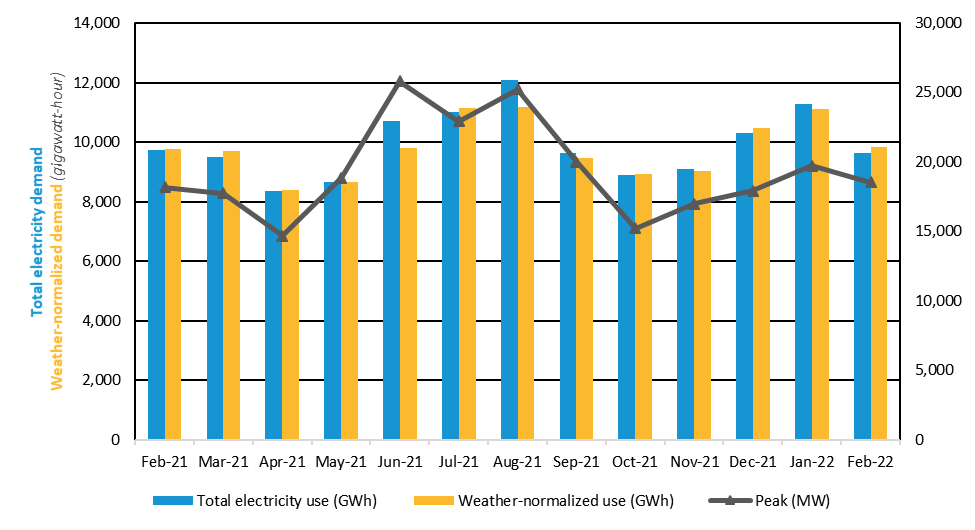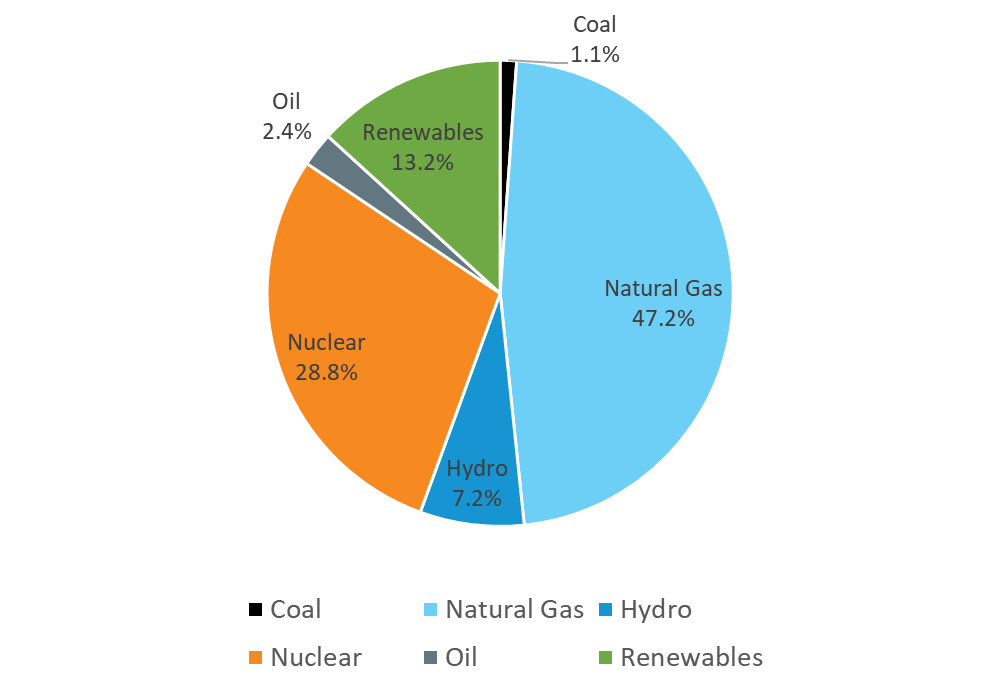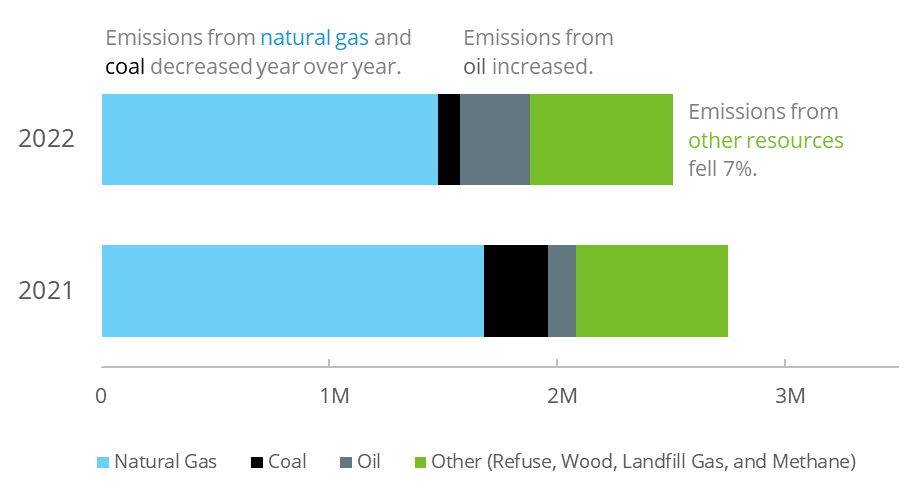Monthly wholesale electricity prices and demand in New England, February 2022
Wholesale power prices averaged $108.67 per megawatt-hour (MWh)1 in the Real-Time Energy Market in February 2022, up 52% compared to the previous year. Day-Ahead Energy Market averages rose to $117.08/MWh, up 60% from February 2021.
February marked the seventh-highest monthly average real-time energy price since the implementation of the current market design in March 2003. The month also saw the eighth-highest average natural gas price, which is a key driver of wholesale electricity prices.
By the numbers
| February 2022 and Percent Change from February 2021 and January 2022 | February 2022 | February 2021 | January 2022 |
| Average Real-Time Electricity Price ($/MWh) | $108.67 | 52.1% | -26.9% |
| Average Natural Gas Price ($/MMBtu) | $14.59 | 70.2% | -27.5% |
| Peak Demand | 18,530 MW | 2.1% | -6.1% |
| Total Electricity Use | 9,642 GWh | -1.1% | -14.5% |
| Weather-Normalized Use2 | 9,853 GWh | 0.9% | -11.4% |
Drivers of wholesale electricity prices
In general, the two main drivers of wholesale electricity prices in New England are the cost of fuel used to produce electricity and consumer demand.
Power plant fuel
Fuel is typically one of the major input costs in producing electricity. Natural gas is the predominant fuel in New England, used to generate 53% of the power produced in 2021 by New England’s power plants, and natural gas-fired power plants usually set the price of wholesale electricity in the region. As a result, average wholesale electricity prices are closely linked to natural gas prices.
The average natural gas price during February was $14.59 per million British thermal units (MMBtu)3. The price was up 70% from the February 2021 average Massachusetts natural gas index price of $8.57/MMBtu. The Mass. index price is a volume-weighted average of trades at four natural gas delivery points in Massachusetts, including two Algonquin points, the Tennessee Gas Pipeline, and the Dracut Interconnect.
February wholesale electricity and natural gas prices

Electricity demand
Demand is driven primarily by weather, as well as economic factors. Energy usage during February decreased 1.1% to 9,642 GWh from the 9,746 GWh used in February 2021. The average temperature during February was 31˚ Fahrenheit (F) in New England, up 2˚ from the previous February. The average dewpoint, a measure of humidity, was 20˚F in February, up 2˚ from the previous February. There were 948 heating degree days4 (HDD) during February, while the normal number of HDD in February is 1,017 in New England. In February 2021, there were 1,011 HDD. There were no cooling degree days in February. ISO New England published weekly reports on the estimated impact on electricity demand of societal changes in response to the COVID-19 pandemic through the end of February 2022.
Consumer demand for electricity for the month peaked on February 1 during the hour from 5 to 6 p.m., when the temperature in New England was 32°F and the dewpoint was 21°. Demand reached 18,530 MW. The February 2022 peak was 2.1% higher than the February 2021 peak of 18,155 MW, set during the hour from 5 to 6 p.m. on February 1, when the temperature was 28°F and the dewpoint was 24°.
Peak demand is driven by weather, which drives the use of heating and air conditioning equipment. The all-time high winter peak was 22,818 MW, recorded during a cold snap in January 2004 when the temperature was -1°F and the dewpoint was -20°. The all-time peak demand in New England was 28,130 MW, recorded during an August 2006 heat wave, when the temperature was 94°F and the dewpoint was 74°. Air conditioning use is far more widespread than electric heating in New England, so weather tends to have a relatively greater impact on the summer peak than the winter peak.
February monthly peak demand and total and weather-normalized energy use

Fuel mix and emissions
The mix of resources used in any given time period depends on price and availability, as well as supplemental resource commitments needed to ensure system stability. Natural gas-fired and nuclear generation produced about 76% of the 7,793 GWh of electric energy generated within New England during February, at about 47% and 29%, respectively. Renewable resources generated about 13% of the energy produced within New England, including 5.8% from wood, refuse, and landfill gas; 5.2% from wind; and 2.1% from grid-connected solar resources (the numbers do not include behind-the-meter solar resources). Coal resources generated 1.1%, while oil-fired resources generated 2.4%. Hydroelectric resources generated 7.2%. The region also received net imports of about 1,964 GWh of electricity from neighboring regions.
February generation in New England, by fuel source

The mix of resources used to produce the region’s electricity is a key driver of CO2 emissions. The ISO estimates these emissions through an analysis that blends data on electricity generation by fuel type with an emissions factor for each fuel developed by the Environmental Protection Agency.
February estimated CO2 emissions in New England, by fuel source (metric tons)

New England power plants produced an estimated 2.5 million metric tons of CO2 in February 2022, down 9% from 2.8 million metric tons in February 2021—and down 40% from January 2022, when CO2 emissions were estimated at 4.18 million metric tons.
Estimated CO2 emissions from natural gas-fired plants fell 12% year over year, from 1.7 million metric tons to 1.5 million metric tons. Estimated emissions from coal-fired plants saw the largest decrease, falling 65% year over year. The drop, from 280,254 metric tons to 97,642 metric tons, reflects the retirement of a coal-fired unit in June 2021. Coal represented a smaller share of the fuel mix in February 2022 compared to last February, when it accounted for 3% of the region’s generation.
Estimated CO2 emissions from oil-fired resources saw the largest year-over-year increase, rising 152%, from 121,397 metric tons in February 2021 to 305,702 metric tons in February 2022. Generation from oil-fired plants tends to increase when natural gas prices are high—as they were in February 2022—because the wholesale markets select the lowest-priced resources to produce the electricity needed to meet consumer demand. Oil-fired generation in February more than doubled from last year, when it accounted for only .9% of the fuel mix.
CO2 emissions from other resources—mostly refuse and wood—were estimated at 625,684 metric tons in February 2022, down 7% from 668,955 metric tons last year.
1One megawatt (MW) of electricity can serve about 750 to 1,000 average homes in New England. A megawatt-hour (MWh) of electricity can serve about 1,000 homes for one hour. One gigawatt-hour (GWh) can serve about 1 million homes for one hour.
2Weather-normalized demand indicates how much electricity would have been consumed if the weather had been the same as the average weather over the last 20 years.
3A British thermal unit (Btu) is used to describe the heat value of fuels, providing a uniform standard for comparing different fuels. One million British thermal units are shown as MMBtu.
4A degree day is a measure of heating or cooling. A zero degree day occurs when no heating or cooling is required; as temperatures drop, more heating days are recorded; when temperatures rise, more cooling days are recorded. The base point for measuring degree days is 65 degrees. Each degree of a day’s mean temperature that is above 65 degrees is counted as one cooling degree day, while each degree of a day’s mean temperature that is below 65 degrees is counted as one heating degree day. A day’s mean temperature of 90 degrees equals 25 cooling degree days, while a day’s mean temperature of 45 degrees equals 20 heating degree days.

Historical weather data provided by DTN, LLC.; Underlying natural gas data furnished by ICE.
- Categories
- Inside ISO New England
- Tags
- monthly prices, wholesale markets
